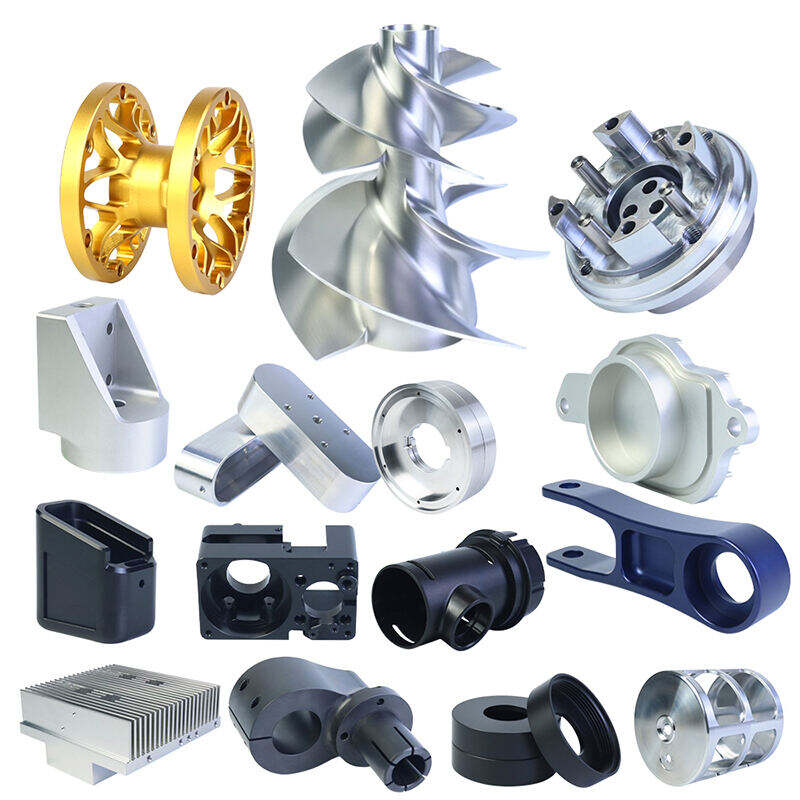Det rytmiske summen fra spindlen, den metalliske lugt af kølevæske på et varmt værktøj og den svage vibration under håndfladen, når emnet er spændt. Denne vibration fortæller dig noget — løse spændeanordninger, et sløvt indsatsværktøj eller et dårligt program. I vores erfaring med at køre arbejdsworkshop og produktionslinjer skiller disse små signaler en problemfri skiftetur fra en nat fyldt med ombearbejdning. Nedenfor guidar jeg dig (og dit indkøbs/konstruktionshold) gennem de fem fejl, vi ser oftest, og præcis hvordan vi har rettet dem — med konkrete trin, tjeklister og indhold, som du direkte kan bruge på dine varebeskrivelser.
Kort sagt — de fem fejl
-
Dårlig fastspænding og fixering → bevægelse af emne, vibrering, affald.
-
Forkert værktøj / tilgangshastigheder og omdrejninger → kort værktøjslevetid, dårlig overfladekvalitet.
-
Utilstrækkelig CAM/postprocessor-opsætning → forkert geometri eller værktøjssbanekollisioner.
-
Utilstrækkelig inspektion og proceskontrol → fejl opdaget for sent.
-
Utilstrækkelig køling/smidning og spånkontrol → overophedning, opbygget kant.
Fejl 1 — Dårlig fastspænding og fixering
Hvordan det ser ud: vibrationsafmærkninger, inkonsistente mål på tværs af et parti, strammet kontrol med værktøjsopbevaring.
Hvorfor det sker: fastgøring, der passer alle, for stor udbøjning, ukorrekt spændingsmoment eller manglende positioneringsfunktioner.
Sådan undgår du det — trin for trin
-
Design til fastspænding: tilføj referencesider og -funktioner under delens design, så dele kan placeres gentagne præcist.
-
Brug modulbaseret fastspænding: bløde tænder, tombstones eller dedikerede fixturer til gentagne familier.
-
Begræns udlæg: hold værktøjsgrib kort; brug støttebakker eller løbende centre hvor det er muligt.
-
Drejmoment- og fastspændingskontrol: standardiser fastspændingsdrejmoment og verificer med drejmomentsnøgle ved hver opsætning.
-
Kør en prøvedel: mål dimensioner på første del og gennemfør en kort produktionstest (5–10 dele).
Praktisk tip vi bruger: For tynde 6061-besklagsdele reducerede skift fra enkeltklampning til en dobbelt-lokator blød tænder omkring 60 % af forkastede dele inden for to uger.
Hurtig tjekliste
-
Er referencesider til stede? ☐
-
Maksimal udbøjning ≤ anbefalet? ☐
-
Er klemmekraft dokumenteret? ☐
-
Er prøvekørsel gennemført? ☐
Fejl 2 — Forkert værktøj, fremføringer og omdrejninger
Hvordan det ser ud: hurtig værktøjsslid, vibrering, dårlig overflade, lange cyklustider.
Hvorfor det sker: at kopiere "typiske" fremføringer fra internettet, forkert værktøjsvalg (forkert geometri eller belægning) eller ikke at justere for maskinens stivhed og materiale.
Sådan undgår du det — trin for trin
-
Vælg den rigtige værktøjsgeometri og belægning til materiale (f.eks. TiN/TiAlN til rustfrit stål; ubelagt carbide eller DLC til aluminium efter behov).
-
Start forsigtigt, optimer hurtigt: indstil tilgangshastighederne til 70 % af anbefalet værdi, og øg derefter i trin på 10 %, mens du overvåger belastningen.
-
Brug spåntynding og trokoidisk fræsning til dybe skulderfræsninger i herdet stål.
-
Log værktøjslevetid og årsager: spor levetiden i dit MES/CNC-værktøjssystem og notér fejlmåder (kanthavari, fladeslid, BUE).
-
Standardiser værktøjsbiblioteker mellem CAM og maskiner for at undgå uoverensstemmelser i værktøjs-id.
Eksempel fra produktionen: Efter omstilling til et 6-fløjets højtydende endefræser til tyndvægget aluminium reducerede vi cykeltiden med 22 % og forbedrede overfladens finish ensartet.
Fejl 3 — Utilstrækkelig CAM- eller postprocessoropsætning
Hvordan det ser ud: udskårne detaljer, forkert værktøjsretning, sammenstød i simulering eller manuelle rettelser, der introducerer fejl.
Hvorfor det sker: Standardindstillinger i CAM, misjusterede råmaterialemodeller eller en forældet postprocessor.
Sådan undgår du det — trin for trin
-
Valider råmateriale- og fixturets geometri i CAM, inden værktøjbaner genereres.
-
Brug simulering og kollisionsdetektion i CAM og kør en tørruning på maskinen (luftkørsel) med nedsat tilgang.
-
Hold postprocessorversionerne opdaterede og oprethold en enkelt kilde for sandhed for postprocessorfiler.
-
Lås kritiske parametre i CAM (indkøringsradius, tilbagetrækningseplaner), så utilsigtede redigeringer ikke ændrer sikkerhedsbevægelser.
-
Dokumentér programrevision og godkendelse : operatøren skal godkende et nyt program, inden der produceres.
Regel fra den virkelige verden: Udfør altid et simuleringstrin for værktøjspassen og en tørrunning med 30 % hastighed ved nye jobopsætninger.
Fejl 4 — Utilstrækkelig inspektion og proceskontrol
Hvordan det ser ud: defekter når nedstrøms processer, høje affaldsniveauer, kundereklamationer.
Hvorfor det sker: inspektion kun i slutningen, ingen SPC eller mangel på mellemværende målinger.
Sådan undgår du det — trin for trin
-
Flyt til venstre i processen: inspicer kritiske dimensioner på det første emne og med fastlagte intervaller (f.eks. hvert 10.-50. emne afhængigt af tolerancen).
-
Brug enkle løbende kontrolmålinger (go/no-go, pluggemål, gevindmål) ved spindelstop.
-
Implementer SPC for nøgledimensioner og udløs alarmer ved tendenser, ikke kun ved specifikationsgrænser.
-
Kalibrer inspectionsværktøjer ugerligt (eller pr. skift ved stramme tolerancer).
-
Uddannelse af operatører i måleteknik — gentagelighed er lige så vigtig som udstyret.
Sagsnote: Vi reducerede omfattende eftersynsreparationer med cirka 70 % efter at have tilføjet to CMM-tjek under produktionen på en præcisionshusningslinje.
Fejl 5 — Forkert køling, smøring og spåntagning
Hvordan det ser ud: opbygget skæregeometri (BUE), termisk forvrængede dele, blokerede værktøjsfløjter.
Hvorfor det sker: forkert kølemidletilslutning, dårlig stråleretning, spån, der genbearbejdes i emnet.
Sådan undgår du det — trin for trin
-
Vælg kølemiddel ud fra materiale: opløselige olieblandinger til stål, højkvalitets syntetiske eller semi-syntetiske til aluminium, og hold korrekt koncentration.
-
Ret stråler mod bearbejdningssonen: brug justerbare stråler og verificer med farvetest hvis nødvendigt.
-
Brug intern køling eller gennem-værktøjskøling, hvor det er relevant.
-
Vedligehold spåntagere og alarmer så spån ikke samler sig i fastspændingsvorde.
-
Overvåg temperatur og overflade: hvis BUE optræder, skift kølevæske og reducer tilgang eller tilføj smøremiddel.
Workshopstip: Til lange aluminiumsprofiler reducerede en højtryskølevæske rettet mod værktøjet BUE-opbygning og forlængede værktøjslevetid med ca. 30 %.
Kort casestudie (vores værksted)
Problem: Batch af præcisionsaerospace-beslag (316L), oprindelig scrap på ca. 8 % pga. vibrationer og uregelmæssige overflader.
Gennemførte tiltag: omdesignede fastspændingsvorde med dobbeltlokatorer, skiftede til belagte carbidskærer og finjusterede tilgange (start ved 70 % og øg gradvist), indførte CMM-kontrol af første del og mellemregulering med drejmomentverifikation.
Resultat (6 uger): affald faldt til ~1,5 % (≈81 % reduktion); cyklustid forbedret med ~14 %.
Indholdsfortegnelse
- Kort sagt — de fem fejl
- Fejl 1 — Dårlig fastspænding og fixering
- Fejl 2 — Forkert værktøj, fremføringer og omdrejninger
- Fejl 3 — Utilstrækkelig CAM- eller postprocessoropsætning
- Fejl 4 — Utilstrækkelig inspektion og proceskontrol
- Fejl 5 — Forkert køling, smøring og spåntagning
- Kort casestudie (vores værksted)


